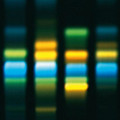
DMT-Nexus member
Posts: 307 Joined: 06-Feb-2013 Last visit: 24-Sep-2014 Location: Nirvana
|
Does DMT show any signs fluorescence at any known wavelengths ? I'm a bit drunk right now & all I'm finding is references to "N,N-dimethyl-p-toluidine (DMT)" when I do a websearch and this sites search engine has a thread about epiflorescence in rue alkaloids, but I couldn't find much about DMT. Maybe it's just this duck duck go search engine I'm using - haha I'm not really that drunk yet. 
|
|
|
|
|

DMT-Nexus member
Posts: 1453 Joined: 05-Apr-2009 Last visit: 02-Feb-2014 Location: hypospace
|
Yes, it is strongly fluorescent, but not in a wavelength visible to the human eye.
the activation spectra is in the range of 280-290 nm and the emission is in the range of 340-370 nm.
it is also reported as piezoluminescent when very pure.
|
|
|

DMT-Nexus member
Posts: 307 Joined: 06-Feb-2013 Last visit: 24-Sep-2014 Location: Nirvana
|
Thanks Albert.
I've been looking at my refractometer lately and wondering if it could be adapted to include a light source in the required wavelength but the emission range will make it unpractical for what I had in mind.
The piezoluminescence is very intriguing, it makes me wonder why evolution encoded that property into an alkaloid. Maybe DMT plays a role in intracellular communication of some sort.
Anyway thanks for the input, much appreciated.
|
|
|

DMT-Nexus member
Posts: 307 Joined: 06-Feb-2013 Last visit: 24-Sep-2014 Location: Nirvana
|
Maybe a webcam could "see" those wavelengths and display it in a histogram or possibly just display it with a few tweaks ?
I'm not looking for a quantitative analysis but if the presence of DMT could be detected in solution easily it could help to decide which samples need further assessment through TLC or spectroscopy ect.
It would make a handy little iphone app
|
|
|
DMT-Nexus member
Posts: 1055 Joined: 21-Nov-2011 Last visit: 15-Oct-2021
|
I think that all materials are fluorescent at some wavelength. Freebase DMT appears to be white, which means it must have multiple fluorescence peaks in the visible range. Using a webcam histogram? That's a really cool idea, but I don't know if the histogram would be precise enough to identify DMT. Anyways, make a histogram of DMT reflectance and of the light source and subtract the two. I'd like to see the result if you try it. Every day I am thankful that I was introduced to psychedelic drugs.
|
|
|

DMT-Nexus member
Posts: 307 Joined: 06-Feb-2013 Last visit: 24-Sep-2014 Location: Nirvana
|
Yeah maybe the refractometer would affect the maths, perhaps just a backlit microscope slide parallel to the camera lens could be better.
Maybe the light source would have to be focused on an angle to allow the camera to see the emitted photons, that's if DMT emits photons on an angle to the light source ?
|
|
|
DMT-Nexus member
Posts: 1055 Joined: 21-Nov-2011 Last visit: 15-Oct-2021
|
Well, they're crystals, I presume. So unless you find a way to deposit them flatly on the glass, the light is going to reflect and refract all over the place. Your best option for controlling the shape of the sample might be to dissolve some dmt crystals in as little solvent as possible, and then press a few drops between two slides and let it dry. The problem is that the fluorescence from such a thin sample would be too weak to pick up with a webcam. Now that I think of it, I don't think this would work because the webcam histogram is not a full spectrum. The best you will get is components of red, green, and blue, and that is not enough to concisely distinguish a particular molecule. If you try it anyway, I recommend starting with just your webcam and light source directly above a pile of crystals in a dark room. The light source shines on the crystals and the webcam picks up reflected light. Subtracting background would mean taking an image with and without the crystals in place and then subtracting the two images. EDIT: Here's how you would pick up the entire spectrum. You make a spectrometer by passing the light reflected from the sample through a quartz prism or a diffraction grating. The different frequencies are separated and then you would have to somehow refocus them onto the CCD of the webcam. This is actually starting to seem doable to me, though it would still take a lot of work and probably wouldn't be that reliable. hixidom attached the following image(s):  Fluorescence experiment.bmp (192kb) downloaded 127 time(s).Every day I am thankful that I was introduced to psychedelic drugs.
|
|
|

DMT-Nexus member
Posts: 307 Joined: 06-Feb-2013 Last visit: 24-Sep-2014 Location: Nirvana
|
My refractometer splits the beam to a certain extent, there certainly is some observable lines of different wavelengths when viewed with the naked eye. It can be focused too. I've adapted a few webcams to photograph images on microscopes over the years, so adapting a refractometer to a camera should be fairly straight forward. Some webcams have a IR/UV filter that could affect histogram readings so it could have to be removed. The design of a standard refractometer would be close to ideal if it had a less acute angle at the prism. I found a bit about ultra violet photography with a Nikon D70 (that's a CCD not a webcam type cmos sensor) from beyondvisible.com and the histograms seem to give some data around the wavelength we need, but I imagine you'd be looking at more of a fingerprint interpereted from the data than a positive reading on any one colour field on a histogram display. Beyond Visible
|
|
|

DMT-Nexus member
Posts: 49 Joined: 27-Feb-2012 Last visit: 28-Dec-2013
|
Hello,
i looked into your idea a littlebit, because i had a similar one..
First of all: A Refractometer is a thing to measure the "Refraction", not the Spectrum of a Lightsource. You are searching for a Spectrometer not a Refractometer!
If we want to do this, we need a way to capture UV-Light down to ~280nm
A CMOS imaging Sensor of a common Webcam does normally capture from 200nm - 1100nm, so it is ideal, if there is no filter on the chip which blocks UV-light and can´t be removed. I tried some cheap webcams and was disapointed with the Chip-size.. The best i found is a PS3 Play cam, it has a chip that is 4mm wide and the chip is very sensitive. Furthermore there are good drivers for that cam (possibility to deactivate automations and do exposures of up to 1 Second!!! It´s also possible to do 180fps, but we won´t need this, as this needs a lot of light + we don´t look for high sampling rate)
When i remove the optics form the cam, it is very sensitive to IR, i had to turn of my Incandescent room lighting, because it just was magnitudes brighter, than every other lightsource (high IR).
For the UV-Range i tested with a 254nm mercury 1,5W Lamp, the chip seems to be very sensitive down to this wavelengths too! The optics with removed IR-Filter seemed to block 254nm UV (i think due to the glass, which absorbs UV)
So it won´t be possible to use the optics, when detecting UV. We have to find a way to directly shine light from a difraction grating to the chip surface..
I used some old CD´s as a difraction grating, but they spread out the light way to much! I know that in professional DAD-Detectors they use a Diode-Array and a diffration grating, however i don´t know whether there are any optics involved or not..
It´s also a challenge to find a lightsource that emmits on 280-290nm.. I guess a deuterium lamp is off limits due to price (~400USD) and you need special driver electronics as well. A Xenon Flashlamp would be easily availible, however detecting would get complicated with a CMOS-Chip then i gues...
Another unknown variable is the relation between excitation and emission light intensity.. If they are magnitudes different, the CMOS-Design won´t really work IMHO, because the excitation wavelength, would overexpose the CMOS and just overblure the emission wavelength..
B.t.w. professional spectrometers with Glasfibre input are arround 2-4kUSD, guess they contain nother other than a difraction grating and a 2 dimmensional Diode array.. But i guess they have a much bigger dynamic range.. But we could emulate this, by doing many exposures with different timings and combine the results to a wide range.
Does anyone know how the optical path inside a digital spectrometer usally works?
Maybe we can just buy some cheapo network glassfibre cables, a difraction grating, a diode array and an arduino? It has a 10-bit ADC
|
|
|

analytical chemist
   
Posts: 7463 Joined: 21-May-2008 Last visit: 09-Aug-2025 Location: the lab
|
i got a working LKB Bromma spec for 66 bucks, quartz cuvette. holds six samples. could interface it to a USB NI DAQ with Signal Express. Check the Merck Index for wavelength(s) of max abs. they're typically listed with log e values. "Nothing is true, everything is permitted." ~ hassan i sabbah
"Experiments are the only means of attaining knowledge at our disposal. The rest is poetry, imagination." -Max Planck
|